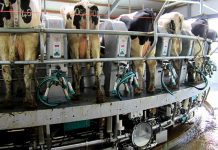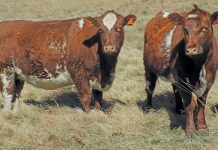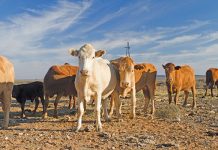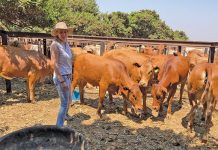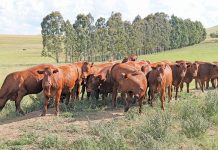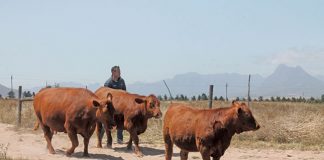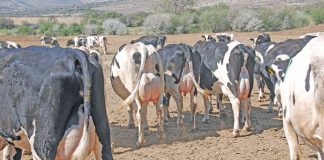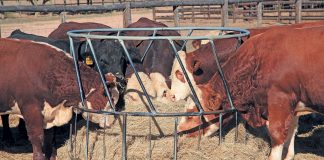There’s big money in disease-free certified buffalo, and the market has grown dramatically in recent years. Unfortunately, in parts of KwaZulu-Natal, it’s now believed these animals could pose a serious health threat to cattle. Buffalo Associated Theileriosis (BAT), commonly referred to as corridor disease and caused by the Theileria parva lawrencei protozoan, doesn’t pose health problems to its typical host, the African buffalo.
But if brown ear ticks transmit the disease to domesticated cattle, they, unlike buffalo, become extremely sick and usually die. If infected buffalo are continually introduced into new areas of KZN, the risk of this disease being spread to more domesticated cattle in the province grows.
Spreading the disease
Dr Dave Cooper, wildlife vet for provincial conservation body Ezemvelo KZN Wildlife, says that before 1995, infected buffalo were confined to the formally protected conservation areas of Hluhluwe-Imfolozi Park, the eastern shores of what is now iSimangaliso Wetland Park, Ndumo Game Reserve, Tembe Elephant Park, and a few private reserves east of the N2 highway in KZN’s Zululand region.
“Since then, the expansion of the game ranching industry has led to an ever increasing demand for buffalo as a keystone species, and the original corridor disease-controlled area in Zululand was extended west of the N2 to include a large area north of the R34 road and south of the R69 road,” Dr Cooper explains.
“The increase in buffalo populations has increased the risk of them breaking out from private game ranches, and corridor disease-carrying brown ear ticks being spread over cattle-grazing areas as a result.”
Origin of corridor disease
The disease was first discovered in South Africa during the 1950s along a corridor of land running between KZN’s Hluhluwe and Imfolozi Game Reserves. When government officials discovered African buffalo were carriers of this disease, and the brown ear tick was the responsible vector, the corridor disease-controlled area was established.
It was forbidden to relocate any buffalo carrying corridor disease outside of this area. In recent years, the market for disease-free certified buffalo has grown dramatically, with buyers prepared to pay upwards of R100 000 each. Last year a bull sold for R3 million, and recently another sold for a record R9,2 million.
However, Dr Cooper says that wherever there might be unscrupulous game traders, there’s the chance that infected buffalo are illegally moved and sold as disease-free animals to unwitting buyers. These infected buffalo have been introduced into supposedly disease-free areas of South Africa. This could spread corridor disease into large sections of the multi-billion rand cattle industry, with devastating results.
Transmission
“Increasingly, communally run cattle in KZN are showing signs of exposure to corridor disease,” says Dr Cooper. “Recently, at two separate communal dip tanks, about 7% of cattle sampled tested positive for the presence of Theileria parva parasites,” says Dr Cooper.“The significance of this is unknown and needs further investigation.
It raises the question of whether the corridor disease strain may have adapted to cattle, thereby facilitating cattle-to-cattle transmission. “This adaptation has been demonstrated under experimental conditions and may have already occurred under natural field conditions in KZN.
A major quarantine should be placed on these cattle movements, and intensive research should be carried out to answer this question.”
Dr Cooper says that accurately diagnosing corridor disease in buffalo and cattle isn’t a simple process. In cattle, a conclusive diagnosis can only be made after a thorough investigation that includes the herd history, clinical examination, pathology and a positive blood result.
Repeatedly testing buffalo may be needed before certification. The accuracy of any laboratory test is questionable as it’s dependent on the degree of sensitivity and specificity, and no single test for the disease can claim to be 100% accurate.
Microscopically, it’s almost impossible to morphologically differentiate between all the known Theileria parasites, and even the current DNA tests can’t distinguish between the buffalo-associated and non-buffalo-associated strains of Theileria parva.
There are three strains of Theileria parva, namely East Coast Fever, caused by T. parva parva, claimed to be eradicated from South Africa in the 1950s; Zimbabwean theileriosis, caused by T. parva bovis, which isn’t thought to occur in South Africa; and corridor disease, caused by T. parva lawrencei.
Less virulent species of this genus include Theileria taurotragi, T. mutans and T. vellifera, among others.“I’d suggest that, while more refined corridor disease diagnosis technologies are being developed, farmers suspecting this disease in their cattle shouldn’t rely solely on a laboratory diagnosis,” says Dr cooper.
“A vet who knows a farmer’s cattle herd’s history should first be called out to do a clinical examination of the sick cattle and an in-field pathological examination. This can give a clearer picture if the cattle are sick with corridor disease or if it’s something else.”
Symptoms of corridor disease
Clinical symptoms in cattle include pyrexia (fever), anorexia (lack of appetite and associated weight loss), oedema (accumulation of fluid) in the eyelids, together with lachrymation (weeping from the eyes), corneal opacity (oedema of the cornea, resulting in a cloudy appearance), generalised lymphadenopathy (swollen lymph nodes), and dyspnoea (laboured breathing).
But Dr Cooper says many of these symptoms are similar to those presented by a number of other diseases, such as heartwater, so cattle farmers shouldn’t assume their cattle are infected simply due to the presence of buffalo on a neighbouring farm, without first having a vet examine them.
Protecting buffalo owners“A buffalo owner can be sued for damages by a cattle farmer who suspects that these buffalo were responsible for infecting his cattle with corridor disease,” says Dr Cooper.
“Buffalo owners must protect themselves from potential legal actions by working closely with their local state veterinarian. They should also use reputable game marketing agents and game capture operators who only sell disease-free certified buffalo to buyers living outside of the controlled area. Remember that it’s illegal to move any buffalo out of the controlled area.”
Buffalo owners with neighbouring cattle farmers should make sure they have fences that are strong enough to prevent these animals from breaking out. In Dr Cooper’s experience, these breakouts generally occur after heavy rain, so buffalo owners should carry out regular fence inspections and promptly repair any faults.
It’s also important for a buffalo owner to notify neighbours immediately of any suspected buffalo breakouts so that cattle farmers can dip against ticks and move cattle from potential corridor disease-infected camps. Cattle farmers could protect their own interests by creating a buffer zone along their fence-line with their buffalo-owning neighbour to reduce the chances of potential disease-carrying brown ear ticks moving from the buffalo farm to the cattle farm.
Any cattle suspected of having corridor disease, whether these cattle are on communal or private land, should be quarantined immediately and examined.
Controlling corridor disease
Dr Cooper says this disease is still difficult to manage effectively, given its complicated nature. If there were no brown ear ticks around to vector corridor disease from buffalo to cattle, these two bovine species could cohabitate. Unfortunately, the effects of climate change and irresponsible movement of buffalo around South Africa could soon result in an even larger geographic footprint of brown ear ticks in the country – with the potential for the increased spread of corridor disease between buffalo and cattle.
So it’s up to buffalo owners, cattle farmers, health professionals and government to work together to find a mutually acceptable and effective solution to this problem.

